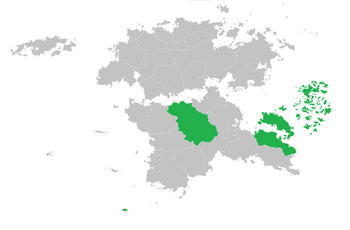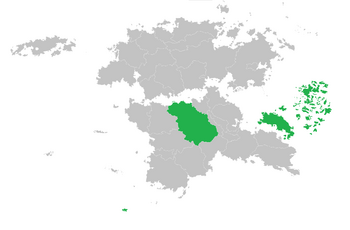Cacertian Empire
This article is incomplete because it is pending further input from participants, or it is a work-in-progress by one author. Please comment on this article's talk page to share your input, comments and questions. Note: To contribute to this article, you may need to seek help from the author(s) of this page. |
Cacertian Empire Impero di Cacerta | |||||||||||||||||||
|---|---|---|---|---|---|---|---|---|---|---|---|---|---|---|---|---|---|---|---|
| 1875–1940 | |||||||||||||||||||
| Motto: Long Live the Empress! | |||||||||||||||||||
| Anthem: Indivisible and Inseperable Indivisibile e Inseparabile (Instrumental) | |||||||||||||||||||
 The Cacertian Empire at its greatest extent in 1905 under Empress Elliana. | |||||||||||||||||||
| Capital and largest city | Vichenza (Primary) and Adygeysk | ||||||||||||||||||
| Common languages | Official: Cacertian, English, Kazar Regional: French, Lirinyii | ||||||||||||||||||
| Religion | Sofianism (Cacerta) and Tyrrism (Kazarakhai) | ||||||||||||||||||
| Demonym(s) | Cacertian, Kazar | ||||||||||||||||||
| Government | Constitutional Monarchy, Personal Union | ||||||||||||||||||
| Empress (of Cacerta-Kazarakhai) | |||||||||||||||||||
• 1875-1938 | Elliana Sarissita | ||||||||||||||||||
• 1938-1940 | Rosalia Sarissita | ||||||||||||||||||
| Khagan (of Kazarakhai) | |||||||||||||||||||
• 1875-1886 | Zaliyne Atabiova (First) | ||||||||||||||||||
| Prime Minister | |||||||||||||||||||
• 1875-1880 | Remo Sottosanti (First) | ||||||||||||||||||
• 1938-1940 | Filomena Marcello (Last) | ||||||||||||||||||
| Legislature | Parliament | ||||||||||||||||||
| House Assembly | |||||||||||||||||||
| Common Assembly | |||||||||||||||||||
| History | |||||||||||||||||||
• Foundation | 22 April 1875 | ||||||||||||||||||
| 2 March 1922 | |||||||||||||||||||
• Lirinyii Indep. | 7 January 1939 | ||||||||||||||||||
• Gylian Indep. | 18 February 1939 | ||||||||||||||||||
• Dissolution | 4 November 1940 | ||||||||||||||||||
| Area | |||||||||||||||||||
| 1905 | 1,266,895 km2 (489,151 sq mi) | ||||||||||||||||||
| Currency | Inganarre (ɫ) | ||||||||||||||||||
| |||||||||||||||||||
| Today part of | |||||||||||||||||||
The Cacertian Empire (Italian: Impero di Cacerta), sometimes referred to as Cacerta-Kazarakhai, was an imperial state founded following the union between the Unified States of Cacerta and the Kazarakhai Khaganate as a result of the marriage between Victor Sarissita and Zaliyne Atabiova. For all intents and purposes, the Cacertian and Kazar states were co-equal with governmental faculties divided between each; foreign affairs and military matters, however, came under joint oversight. The combined Empire existed from 1875 to 1922 before political dissatisfaction in Shirvaniya led to the Shirvani Revolution, its separation from the union, and the foundation of the Shirvani Dominion. The Cacertian Empire continued on its own until its eventual dissolution in 1940 following economic turmoil in the wake of the Siduri War.
Cacerta-Kazarakhai was a multinational state as well as a great power. Elliana pursued a period of rapid militarization beginning with the annexation of Dreyesau in 1875 and later the successful invasion of neighboring Lirinya in 1876. Her policy went on to develop the nation into a well-armed naval power, second only to Ossoria, and possessing a highly-trained professional army. It saw the development and creation of airships which led to the innovation and commercialization of air travel. By the early 1900s, the Empire had built up one of the largest machine building industries in the region and was a major exporter of industrial and electric appliances.
The decline of the Empire is often considered to begin following the start of the Divide War. Meant to secure a logistics base both on the Sundering Sea as well as support loyal crown forces against the revolt in Kazarakhai, it quickly turned into a conflict of attrition with Syaran forces providing more resistance than initially anticipated. The war went on to exacerbate political upheaval which ignited further support for the revolution. The collapse of the union resulted in an economic downturn in Cacerta that led to the Empire granting independence to several of its territories. By the end of the Siduri War, the Cacertian Empire had already effectively dissolved with its disbandment later finalized in the Cacertian Constitution of 1940.
Name
The realm’s full, official name was The Unified States of the Cacertian Islands in Union with the Kazarakhai Khaganate (Cacertian: Gli Stati Unificati delle Isole di Cacerta in Unione con il Khaganato di Kazarai).
History
Creation
Expansion
Annexation of Dreyesau
Lirinyii Campaign
Annexation of Knichus
Cacerta-Xevden War
Shirvani Revolution
As early as 1874, there was a faction of the Kazar Royal government which objected to the unification of the Kingdom with Cacerta. Although the early successes of Elliana's reign quieted them, it was only a matter of time before dissatisfaction with Kazarakhai's status within the Empire began to return. Due to the country usually being under the administration of a regent, only receiving the monarch's attention during times of crises, a perception began to grow that Kazarakhai was considered less important, or second class, than the Cacertian home islands.
Although the initial regents selected by Elliana were capable enough, the stresses of administering a nation as large as Kazarakhai caused a high turnover rate among them, and by 1894 there were widespread perceptions of mismanagement of the Kingdom's budgeting and social services. These perceptions led to major protests in several Kazar cities in the spring of 1907. Soldiers of the Kazar National Guard were deployed to prevent violence at the protests, but during a protest in Jorvyk, guardsmen fired on protesters, triggering a riot.
Attempts to quash the riots only caused them to spread, and a full-on revolt had taken root by the winter of 1908. Although forces loyal to the royal government were able to hold several cities and drive off rebels, the rebels were able to consolidate their hold on a few port cities and several cities in the interior, and both sides settled in for a war of attrition.
On 21 September 1912, the Shirvani Dominion was proclaimed in Imishli. However, the Dominion would not encompass the entirety of Shirvaniya until the signing of the Peace of Imishli on 2 March 1922.
Divide War
Siduri War
Decline and Dissolution
Territory
When Elliana succeeded her father, she received the title of ruler of the Unified States of Cacerta and—by extension of her father’s marriage to Khagan Zaliyne—the title of ruler of the Kazarakhai Khaganate. She inherited the thrones of two separate states that had grown excessively close over the course of her parents union despite their distance. After extensive negotiations with her ministers, counselors, and confidants and with the permission of her mother, Elliana founded a combined state under the governance of a single authority. The Cacertian Empire’s military growth resulted in a campaign of expansion that transformed the dual monarchy into a global power by 1880.
Successor States
The following successor states were formed on the territory of the former Cacertian Empire:
- The Kingdom of Cacerta was eventually created following the finalization of the dissolution of the Empire in 1940.
- Although the Republic of Kazarakhai was officially created in 1912, the Republic did not possess full control of Kazarakhai until 1922 following the conclusion of the Kazar Revolution.
- The Serene Federation of Lirinya was granted its independence as a sovereign nation in the final years of Elliana’s rule in 1937.
- The territories of the Empire that had been seized from the Kingdom of Xevden would become part of the Gylian Free Territories that played a significant role in the Liberation War and the later creation of the Republic of Gylias.
The Kingdom of Cacerta maintained the territory of Andria and the island of Dreyesau following the dissolution. Dreyesau would eventually be granted its independence in the year after the conclusion of the Siduri War.
Demographics
Population
Peoples
Population Centers
Languages
Government
The Sarissita-Atabiova Monarch ruled as Empress over the Cacertian half of the country that was made of the islands of the Cacertian Archipelago and as the Khagan of Kazarakhai over the Kazarakhai Khaganate. As a result of the distance separating the realm, the Kazarakhai half of the Empire was often overseen by an appointed regent as the primary capital was located in Cacerta. Upon its official foundation in 1875, Empress Elliana made the decision that the realm would be known as the Cacertian Empire in its international relations in order to simplify affairs.
There were three components that formed the government of the Cacertian Empire. The combined foreign, military, and financial administration made up the largest contingent of the Empire’s governing body and was seated in the Cacertian city of Vichenza. Both Cacerta and Kazarakhai, however, still possessed their own separate national governments and possessed considerable autonomy although they were tightly linked through the authority of the monarchy. The monarch possessed the right to royal assent, which was key prior to the passage of any bills in either government, as well as the right to veto all legislation passed.
The monarch’s Combined Government, of which all ministers were directly appointed by the monarch and responsible to then, maintained the responsibility of assembling and budgeting the army and navy as well as handling foreign policy and national finances. The Imperial Council ruled the combined government and comprised of the monarch, confidants, and six ministers with two representatives from each half of the nation for each of the three ministries. While the Imperial Council could be consulted by either government, the appointed ministers ultimately answered to the ruling monarch who possessed the final say in all matters of military and foreign policy.
Armed Forces
The military, despite the great distance between Kazarakhai and Cacerta, was organized similarly under the monarchy. The land component of the Empire’s armed forces was comprised of three unique parts that consisted of the Combined Army and two special armies (the Cacertian Guardie Imperiali and Kazar Royal Guard) for national defense based in their respective halves of the nation. Each of the special armies were considered separate national institutions and were administered by their respective ministries of national defense. The Combined Army was the largest part of the Cacertian-Kazar land forces, consisted of both Cacertian and Kazar regular troops, and was overseen by the Joint Minister of War.
The advent of airships and airplanes saw the development of a division of the Combined Army dedicated entirely to aerial warfare. The Imperial Air Service began as a reconnaissance balloon corps in 1887 under the command of the army. It was eventually re-organized into its own formal branch by 1892 with the creation of the Empire’s first purpose-built military airships and, later, fighter planes.
The Cacertian Empire’s Navy was the largest branch of the armed forces and was under the direct command of the Grand Admiral of the Imperial Navy. Although the branch was theoretically meant to be administered by the Joint Minister of War, the size and prestige of the Navy often allowed it to operate virtually separate from the Imperial War Council and, instead, reported directly to the Empress. At the height of its power in the 1890s and 1900s, the Imperial Navy was one of the largest blue-water navies in operation at the time.
The term of service in the Combined Army and Navy was a minimum of three years on active duty with an additional six to seven years in the reserve.
Economy
The economies of Kazarakhai and the Kingdom of Vichenza began intermingling closely in the years following the marriage of Victor and Zaliyne. After Elliana’s succession of the throne in Cacerta, Elliana began extending that foundation of trade throughout the entirety of the Unified States. By 1885, the combined economy of the Cacertian Empire had become one of the largest economies in the region. Technological change accelerated industrialization and urbanization in both halves of the Empire, ushering in a golden era of economic growth.
Heavy industry became a major focus in the Empire’s economy especially after Elliana’s bid to begin producing a massive blue-water dreadnought navy. While Cacerta possessed the expertise and facilities to produce warships in mass quantities, it severely lacked the needed raw resources to tackle the projected growth. Much of the refined iron and steel used to create most of the dreadnoughts between 1875 and 1900 were products of Kazarakhai.
Locomotives and railways became an integral part of the Empire’s infrastructure within Kazarakhai. Initially lacking the technological base, Kazarakhai imported hardware and engineers from the Acrean Empire and eventually learned the skills required to expand and operate railways. Most of the cities within the Kazar half of the Empire constructed railway shops that became centers of technological development and, by 1880, Kazarakhai was self-sufficient enough to meet the demands of railroad construction. Alongside the shipbuilding industry in Cacerta, the Kazar railway network was a major impetus for growth in its steel industry.
Industrial growth occurred dynamically within the Cacertian Empire and allowed Cacertian and Kazar manufacturers to begin competing—and later capturing—domestic markets from Acrean, Azuran, and Ossorian imports. Kazar metal industries had grown internationally competitive by 1881 as a result of growing organization and technical efficiency whereas Cacerta’s chemical industry grew exponentially. In 1885, the Cacertian Empire had become a dominant economic power in Siduri and one of the largest exporting nations in the region.
Infrastructure
Transportation
The distance and composition of both Cacerta and Kazarakhai resulted in both national governments taking control and investing in their own transportation networks. Initially, the two halves of the Empire were solely connected by steamer ships that traveled through the Bara and Sundering Seas. After the invention of airships and airplanes, airship lines and aircraft routes were later created to expedite trade and transportation.
Ferry Network in Cacerta
As Cacerta was a collective of hundreds of islands, the Unified States organized and developed a substantial core network of ferries and boats that traveled to and from various ports and cities. As a result of its location and the ruling House’s familiarity with the sea, Fumicino became the nexus for many of the ferry lines across the archipelago. Cacerta’s first regularly scheduled and long-distance ferry line between Fumicino and the seaside town of Massa (which serviced the Empire’s capital of Vichenza) opened in 1829. The first ferry line between Fumicino and the regional capital of Viareggio opened one month later. Much of these plotted lines and their associated water ferries were in state hands and were maintained by the government of Cacerta.





